The AMD Ryzen 5 2500X and Ryzen 3 2300X CPU Review
by Ian Cutress on February 11, 2019 11:45 AM ESTCPU Performance: System Tests
Our System Test section focuses significantly on real-world testing, user experience, with a slight nod to throughput. In this section we cover application loading time, image processing, simple scientific physics, emulation, neural simulation, optimized compute, and 3D model development, with a combination of readily available and custom software. For some of these tests, the bigger suites such as PCMark do cover them (we publish those values in our office section), although multiple perspectives is always beneficial. In all our tests we will explain in-depth what is being tested, and how we are testing.
All of our benchmark results can also be found in our benchmark engine, Bench.
Application Load: GIMP 2.10.4
One of the most important aspects about user experience and workflow is how fast does a system respond. A good test of this is to see how long it takes for an application to load. Most applications these days, when on an SSD, load fairly instantly, however some office tools require asset pre-loading before being available. Most operating systems employ caching as well, so when certain software is loaded repeatedly (web browser, office tools), then can be initialized much quicker.
In our last suite, we tested how long it took to load a large PDF in Adobe Acrobat. Unfortunately this test was a nightmare to program for, and didn’t transfer over to Win10 RS3 easily. In the meantime we discovered an application that can automate this test, and we put it up against GIMP, a popular free open-source online photo editing tool, and the major alternative to Adobe Photoshop. We set it to load a large 50MB design template, and perform the load 10 times with 10 seconds in-between each. Due to caching, the first 3-5 results are often slower than the rest, and time to cache can be inconsistent, we take the average of the last five results to show CPU processing on cached loading.

Loading a program is usually a single threaded issue, and the Intel chips do well here. Our two AMD chips turbo to the same frequency, so they score roughly the same.
FCAT: Image Processing
The FCAT software was developed to help detect microstuttering, dropped frames, and run frames in graphics benchmarks when two accelerators were paired together to render a scene. Due to game engines and graphics drivers, not all GPU combinations performed ideally, which led to this software fixing colors to each rendered frame and dynamic raw recording of the data using a video capture device.
The FCAT software takes that recorded video, which in our case is 90 seconds of a 1440p run of Rise of the Tomb Raider, and processes that color data into frame time data so the system can plot an ‘observed’ frame rate, and correlate that to the power consumption of the accelerators. This test, by virtue of how quickly it was put together, is single threaded. We run the process and report the time to completion.
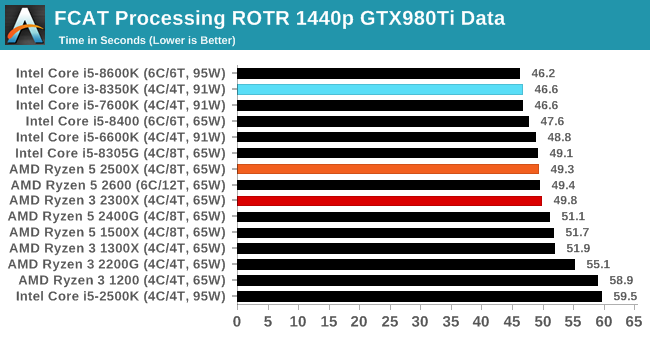
FCAT is single thread driven, and so the Intel chips do well here as well. The 2500X is beating the 2300X, just, as they both turbo to the same amount.
3D Particle Movement v2.1: Brownian Motion
Our 3DPM test is a custom built benchmark designed to simulate six different particle movement algorithms of points in a 3D space. The algorithms were developed as part of my PhD., and while ultimately perform best on a GPU, provide a good idea on how instruction streams are interpreted by different microarchitectures.
A key part of the algorithms is the random number generation – we use relatively fast generation which ends up implementing dependency chains in the code. The upgrade over the naïve first version of this code solved for false sharing in the caches, a major bottleneck. We are also looking at AVX2 and AVX512 versions of this benchmark for future reviews.
For this test, we run a stock particle set over the six algorithms for 20 seconds apiece, with 10 second pauses, and report the total rate of particle movement, in millions of operations (movements) per second. We have a non-AVX version and an AVX version, with the latter implementing AVX512 and AVX2 where possible.
3DPM v2.1 can be downloaded from our server: 3DPMv2.1.rar (13.0 MB)
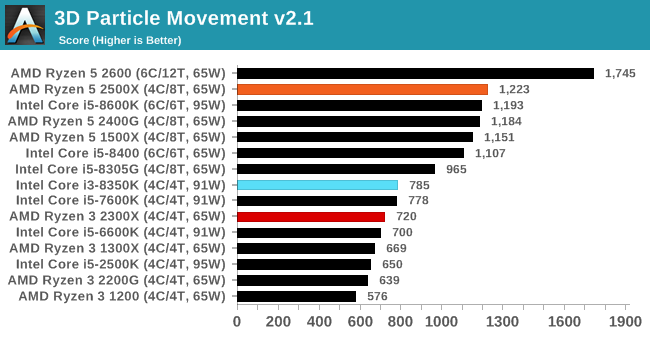
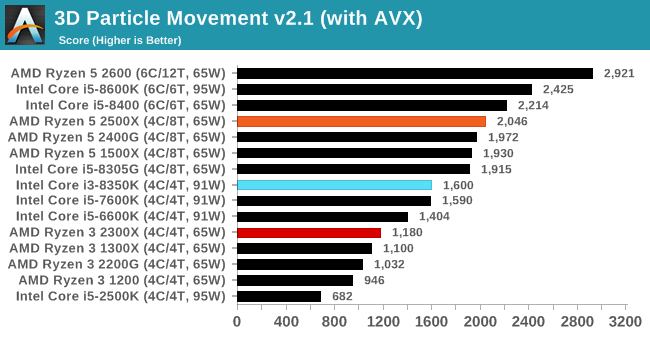
With more threads, the 2500X steams ahead, although it is worth noting that without AVX, the 2300X and 8350K are relatively close, but the gap widens when we add AVX2 to the mix. The Intel chip actually more than doubles its performance, whereas AMD gets around 50% more.
Dolphin 5.0: Console Emulation
One of the popular requested tests in our suite is to do with console emulation. Being able to pick up a game from an older system and run it as expected depends on the overhead of the emulator: it takes a significantly more powerful x86 system to be able to accurately emulate an older non-x86 console, especially if code for that console was made to abuse certain physical bugs in the hardware.
For our test, we use the popular Dolphin emulation software, and run a compute project through it to determine how close to a standard console system our processors can emulate. In this test, a Nintendo Wii would take around 1050 seconds.
The latest version of Dolphin can be downloaded from https://dolphin-emu.org/
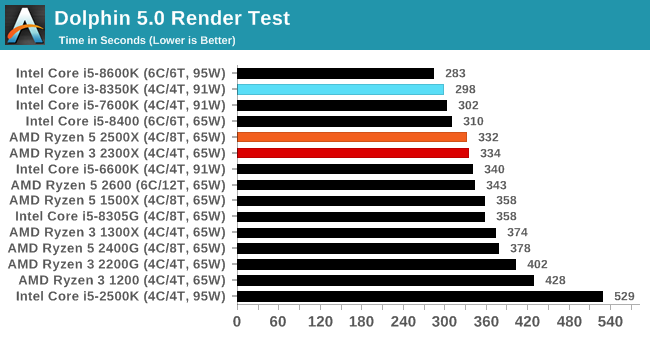
Dolphin is very single thread driven, and so the Intel chips win again, with both of our AMD CPUs scoring roughly the same.
DigiCortex 1.20: Sea Slug Brain Simulation
This benchmark was originally designed for simulation and visualization of neuron and synapse activity, as is commonly found in the brain. The software comes with a variety of benchmark modes, and we take the small benchmark which runs a 32k neuron / 1.8B synapse simulation, equivalent to a Sea Slug.

Example of a 2.1B neuron simulation
We report the results as the ability to simulate the data as a fraction of real-time, so anything above a ‘one’ is suitable for real-time work. Out of the two modes, a ‘non-firing’ mode which is DRAM heavy and a ‘firing’ mode which has CPU work, we choose the latter. Despite this, the benchmark is still affected by DRAM speed a fair amount.
DigiCortex can be downloaded from http://www.digicortex.net/

When it comes to Digi-Cortex, the AMD CPUs have the upper hand here. Both the 2500X and 2300X crush most of the Intel chips, helped a lot by their higher supported memory frequency.
y-Cruncher v0.7.6: Microarchitecture Optimized Compute
I’ve known about y-Cruncher for a while, as a tool to help compute various mathematical constants, but it wasn’t until I began talking with its developer, Alex Yee, a researcher from NWU and now software optimization developer, that I realized that he has optimized the software like crazy to get the best performance. Naturally, any simulation that can take 20+ days can benefit from a 1% performance increase! Alex started y-cruncher as a high-school project, but it is now at a state where Alex is keeping it up to date to take advantage of the latest instruction sets before they are even made available in hardware.
For our test we run y-cruncher v0.7.6 through all the different optimized variants of the binary, single threaded and multi-threaded, including the AVX-512 optimized binaries. The test is to calculate 250m digits of Pi, and we use the single threaded and multi-threaded versions of this test.
Users can download y-cruncher from Alex’s website: http://www.numberworld.org/y-cruncher/
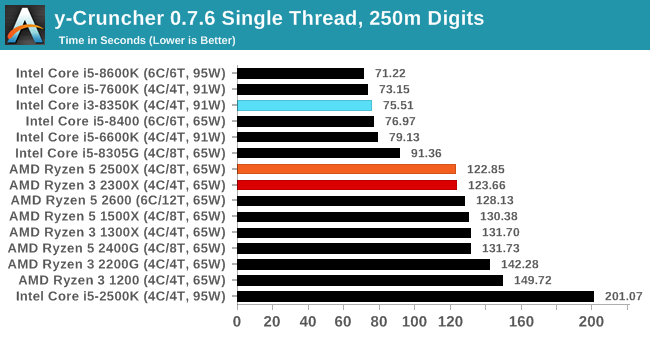

Intel's strong AVX2 performance shows in our y-Cruncher tests.
Agisoft Photoscan 1.3.3: 2D Image to 3D Model Conversion
One of the ISVs that we have worked with for a number of years is Agisoft, who develop software called PhotoScan that transforms a number of 2D images into a 3D model. This is an important tool in model development and archiving, and relies on a number of single threaded and multi-threaded algorithms to go from one side of the computation to the other.
In our test, we take v1.3.3 of the software with a good sized data set of 84 x 18 megapixel photos and push it through a reasonably fast variant of the algorithms, but is still more stringent than our 2017 test. We report the total time to complete the process.
Agisoft’s Photoscan website can be found here: http://www.agisoft.com/

Agisoft likes a mix of threads and IPC, and the Intel CPU sits between our quad-core and quad-core with simultaneous multithreading AMD CPUs. Moving up to the 2600 from the 2500X gives a reasonable 10%+ gain in performance.












65 Comments
View All Comments
Smell This - Tuesday, February 12, 2019 - link
Thanks, Yall!"Where possible, we will extend out testing to include faster memory modules either at the same time as the review or a later date."
____ _____ _____ _____ _______
It would be sweet with some OC action, too.
Most impressive is the jump between the AMD Ryzen 2500X/1500X and Ryzen 3 2300X/1300X --- roughly 10% +/-. Good work, AMD.
I guess this is the difference between Zen and Zen+. With 7nm Zen ++ arriving soon, and Zen+++ next year, the CPU times they are a changin' ...
mr_yogi - Tuesday, February 12, 2019 - link
Love the inclusion of the i5 2500K, great job.Valantar - Tuesday, February 12, 2019 - link
These are both available from Norwegian retailers, though prices are ... not good. The 2500X costs as much as the 2600X, and the 2300X is barely cheaper than the 2600 (though admittedly the 2600 is _really_ cheap).urbanman2004 - Tuesday, February 12, 2019 - link
Reviewing CPU's that'll never reach the mainstream open market. Smart idea Anandtech 😉mikato - Thursday, April 4, 2019 - link
Are you saying it doesn't count if they are sold in prebuilt systems?tygrus - Tuesday, February 12, 2019 - link
AMD APUs (2400G & 2300G) try to keep atleast 50% of the power budget for GPU so the CPU load graph doesn't show the whole picture. It shows the power used for all chips for CPU load not CPU+GPU load. While having a mixture of CPU-only & CPU+GPU chips present means you want to focus on the CPU the reader needs to be reminded that the CPU+GPU load will be higher.I wish AMD had option for 95w TDP APU to compete with Intel models. With more CPU cores/headroom and 25% more GPU to use that 95w+ peak.
azrael- - Wednesday, February 13, 2019 - link
One reason to favor the 2300X and 2500X over the 'G' series CPUs is that Pinnacle Ridge supports ECC whereas Raven Ridge does not.Icehawk - Wednesday, February 13, 2019 - link
I'm begging here - can you please, please, please show us your config settings for the HEVC encoding? You get rates that are 6x+ faster than I can achieve - my O/C'd 8700k gets ~45fps with 1080 Fast 3500 settings using all else as default in Handbrake. I'd really love to hit the #s you get with just an i5. Help!Ian Cutress - Friday, February 15, 2019 - link
Check page 3?https://www.anandtech.com/show/13945/the-amd-ryzen...
xrror - Wednesday, February 13, 2019 - link
One additional savings for OEMs - they won't need to populate the motherboard components for integrated video on systems shipped with these.No need for displayport/HDMI/VGA connectors and associated filtering bits, so that saves a bit more on total BOM for the OEM.